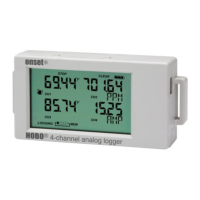Chapter 3: Understanding the logger
8 HOBO Energy Logger Pro User’s Guide
Chapter 3:
Understanding the logger
This chapter discusses the following topics in depth:
a Sensor excitation
a Modules and sensors
a Time accuracy
a Batteries
a Memory
Sensor excitation
Sensor excitation is a voltage output provided by the logger to power a sensor that is connected to it. This power
may be needed because the sensor is not self-powered, or because the sensor’s power capacity cannot support a long
deployment.
When sensor excitation is required, the logger can provide 12 V DC sensor excitation voltage up to 200 mA total for
transducers that require external power for proper operation. The excitation voltage has a programmable warmup
time and is controlled by the FlexSmart Analog module. Excitation is controlled on a per-module basis.
Excitation power can drastically reduce logger battery life. If your sensor does not require it, you should not include
it in the channel configuration. If you do need to use it, carefully select the sensor excitation mode that best meets
your needs. Two modes are available:
• Warmup mode – The logger supplies excitation power for a brief, user-programmable period prior to each
measurement. This mode allows you to select the minimum warmup time needed to allow for sensor
stabilization, while conserving the logger’s battery power. For example, if you specify a
Warm Up of one
second and set the
Logging Interval in the logger to one minute, the logger will power the external sensor for
one second, log a measurement, and then turn off the excitation power for the next 59 seconds. The
warmup time can be up to 120 seconds.
Tip: If the warmup time selected is greater than the logging interval selected, the logger will interpret the
excitation mode as continuous.
• Continuous mode – The logger supplies constant excitation power to the sensor for the entire duration of
the deployment. This mode will result in the shortest battery life. Continuous mode is required if the sensor
needs more than two minutes of warmup time. If you need to provide continuous excitation to a sensor, you
should consider backing up your batteries with an external power source. Refer to “External power
sources” on p. 14 for details.
Important: When using excitation power, always enable the logger’s internal battery channel at launch. If the
battery becomes too low to provide excitation power, excitation power is turned off, but logging continues as long as
the battery can power the logger. This will cause the further readings on that channel to become inaccurate. If you
are logging the internal battery channel when this happens, an “Excitation Off” event will be shown in your datafile
to mark the point at which excitation power was disabled. (If you do not log the internal battery channel, you will
not have anything in your datafile to identify the point beyond which the data might be inaccurate.)

